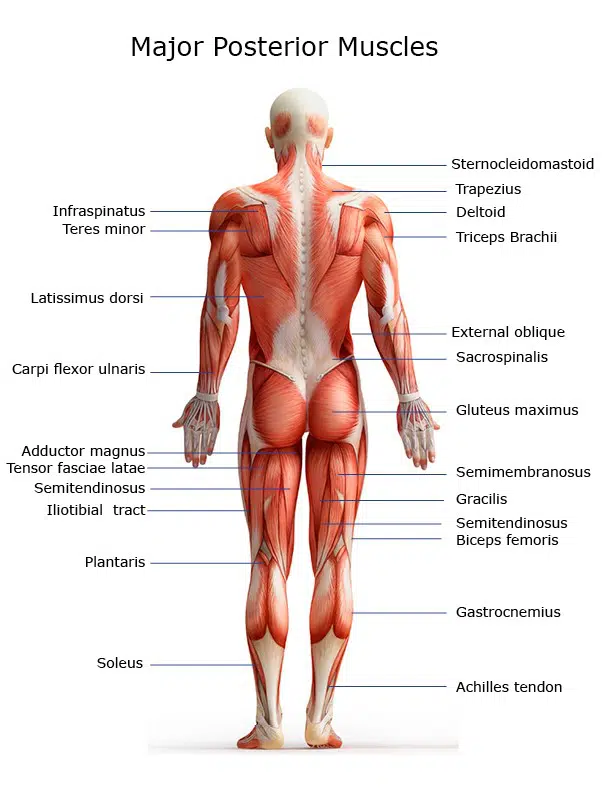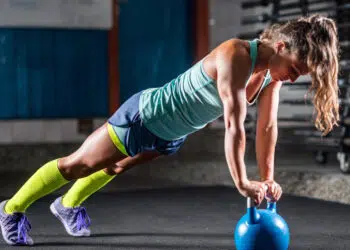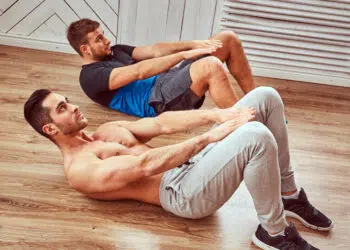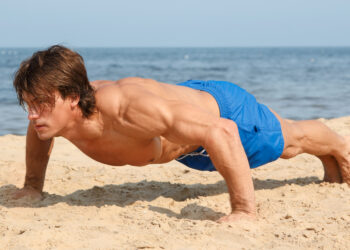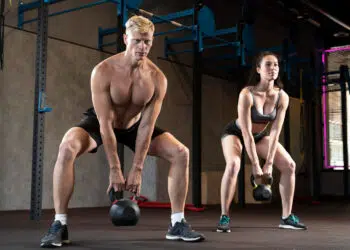There are quite a lot of exercises named after animals, and that’s especially true in yoga. That’s because many of the things that animals do naturally are also very good for the human body. Examples include downward dogs, the cat/cow stretch, bear and leopard crawls, and, now, the crab walk.
Crab walks are a fun but challenging total body exercise that’s ideal for circuit training and HIIT workouts.
In this article, we reveal how and why to do crab walks and provide you with several equally effective variations and alternatives.
Crab Walk – Muscles Worked
Crab walks are a compound exercise which means they involve two or more joints and several muscles working together. Because this exercise works your upper and lower body, it can safely be classed as a full-body exercise. However, the nature of this movement means it’s mainly a posterior chain exercise as it mostly works the muscles on the back of your body.
The main muscles involved in crab walks are:
Level Up Your Fitness: Join our 💪 strong community in Fitness Volt Newsletter. Get daily inspiration, expert-backed workouts, nutrition tips, the latest in strength sports, and the support you need to reach your goals. Subscribe for free!
Triceps – located on the back of your arm, the triceps extend your elbow, and you’ll be using them to support the weight of your upper body. Crab walks are an excellent way to tone and strengthen your triceps.
Deltoids – your deltoids are your shoulder muscles. There are three deltoids (anterior, medial, and posterior), but crab walks primarily work your posterior or rear deltoids.
Trapezius and rhomboids – the trapezius or traps for short is the large diamond-shaped muscle of your upper back. Located across and between your scapulae or shoulder blades, it’s responsible for keeping your shoulders down and back. Shoulder retraction is achieved in conjunction with the rhomboids, which are located between the shoulder blades and beneath the traps.
Latissimus dorsi – the lats are the largest of the back muscles. Located on the side of your body, the lats extend your shoulders during crab walks. The harder you push your arms back, the more work your lats must do.
Core – this is the collective term for the midsection muscles, including the rectus abdominis, erector spinae, obliques, and transverse abdominis. These muscles work together to support and stabilize your lumbar spine.
Gluteus maximus – known as your glutes for short, this is the largest muscle in the human body. It’s one of your main hip extenders and has a lot of work to do during crab walks.
Hamstrings – located on the back of your thigh, the hamstrings flex your knee and extend your hips. Crab walking forward increases hamstring activation, as these muscles are required to pull you along.
Quadriceps – known as the quads for short, the quadriceps extend your knee joint and also flex your hip. Located on the front of your thigh, crab walking backward increases quadriceps activation as you’ll use these muscles to push you along.
How to Do Crab Walks
Get the most from crab walks by doing them correctly. The proper technique will ensure that you keep the stress on the target muscles and off your joints, keeping your risk of injury to a minimum.
How to do it:
- Sit on the floor with your legs bent and feet flat. Place your hands on the floor slightly behind your hips, fingers pointing forward. Brace your core and lift your butt a 6-12 inches off the floor.
- Without locking your elbows, scuttle forward, backward, and sideways without letting your butt touch back down.
- Take care not to lift your hips too high, as doing so puts your shoulders into a hyperextended position, which could cause shoulder pain. Also, try not to round your lumbar spine excessively, as that could result in lower back pain.
Crab Walk Benefits and Drawbacks
Reasons to add crab walks to your workouts include:
Full-body exercise – if you’re short of time but still want to train all your major muscles, crab walks are a good option. Just a few minutes of this exercise will condition and tone many of your main muscles.
Do it anywhere, anytime – with no equipment required, this is a very convenient exercise. While nothing is stopping you from doing it at the gym, you could also do crab walks at home, at the park, or anywhere else you’ve got some space to scuttle.
Good for coordination and balance – walking like a crab will test your body in new ways. Walking upright will feel SO much easier after a few sets of crab walks! This atypical exercise is good for coordination and balance, which could help you move better.
Easy to learn, hard to master – the crab walk is a basic exercise, and most people should be able to get to grips with it fairly quickly. However, despite its simplicity, this is a surprisingly demanding exercise, especially if you do it for a minute or two at a time. As such, it’s suitable for beginner, intermediate, and advanced exercisers.
Fun, unusual exercise – the one thing missing from a lot of workouts is fun! This exercise looks a little ridiculous, but that disguises just how effective and challenging it is. Why not have fun, smile, and laugh during your workout with crab walks?
While crab walks are a mostly beneficial exercise, there are also a few drawbacks to consider:
Level Up Your Fitness: Join our 💪 strong community in Fitness Volt Newsletter. Get daily inspiration, expert-backed workouts, nutrition tips, the latest in strength sports, and the support you need to reach your goals. Subscribe for free!
Hard on the wrists – you’ll need to support your weight on bent wrists when you do crab walks. This may be uncomfortable, especially if you have tight forearms or a history of carpal tunnel syndrome or repetitive strain injuries (RSI).
Limited overload – the only way to make crab walks harder is to do them for longer; your body weight is your only source of resistance. Unless you are prepared to do long sets of crab walks, you may find that this exercise is not challenging enough for you.
Not a bodybuilding/strength exercise – while this is not a true disadvantage per se, if you want or build bigger triceps or more muscular legs, this isn’t the exercise for you. Instead, it’s more of an endurance/conditioning move.
7 Crab Walk Variations and Alternatives
While crab walks are an effective exercise, it won’t take long for them to lose some of their potency if you do them too often. Also, if they aren’t challenging enough for you, crab walks won’t be as rewarding. Keep your workouts fresh and productive with these crab walk variations and alternatives.
1. Reverse high plank
Where crab walks are a dynamic exercise that involves lots of movement, the reverse high plank is more static. However, despite the stationary nature of this exercise, it still manages to work most of the same muscles. However, this is not such a good exercise for HIIT workouts as it won’t push your heart rate up as much.
Learn more about this challenging crab walk alternative here.
2. Crab crossover toe touch
This crab walk variation adds a strong core element to your workout. It’s a static move that starts in the usual crab position. Try doing a set of crab crossover toe touches and then transition into forward and backward crab walks.
How to do it:
- Sit on the floor with your legs bent and feet flat. Place your hands on the floor slightly behind your hips, fingers pointing forward. Brace your core and lift your butt a few inches off the floor.
- Keeping your hips up, lift your left leg and right arm, and reach up to touch your toe.
- Return to the starting position, swap sides, and repeat.
- You can also take your elbow to your bent knee, which is somewhat easier.
3. Bear Crawl
Bear crawls are very much the opposite of crab walks, so they’re a great way to ensure your workouts are balanced. Where crab walks are a mostly posterior chain exercise, bear crawls focus more on the muscles on the front of your body, especially your abs.
Try doing a set of crab walks immediately followed by bear crawls for a short but intense full-body equipment-free workout.
How to do it:
- Kneel down on all fours, so your arms are vertical, and so are your thighs. Lift your knees a few inches off the floor. Engage your abs.
- Without lifting your butt much higher than your shoulders, walk forward in your quadruped position.
- You can also walk backward and sideways.
4. Duck walk
While duck walks don’t work your upper body like crab walks, they’re another unusual way to train and challenge your legs. Take care, though, as this exercise can be hard on your knee joints.
How to do it:
- With your feet shoulder-width apart, descend into a deep squat.
- Without coming back up, shift your weight over onto one leg and take a small step forward with the other foot.
- Continue walking forward as many steps as required.
- You can also do this exercise by traveling backward.
5. Barbell hip thrust
If crab walks no longer present much of a challenge, or you want to develop glute strength and size more than endurance, the barbell hip thrust could be the exercise you have been looking for. With this move, you can go as light or as heavy as you wish, so it’s an exercise that really grows with you.
While it may lack the upper body involvement of crab walks, this is arguably a better exercise for your glutes and hamstrings.
Read all about barbell hip thrusts here.
6. Kettlebell swing
While we are the first to admit that the kettlebell swing looks nothing like crab walks, if you analyze the movement and muscles involved, you’ll soon see there are some similarities, and swings are just as good for your posterior chain as crab walks.
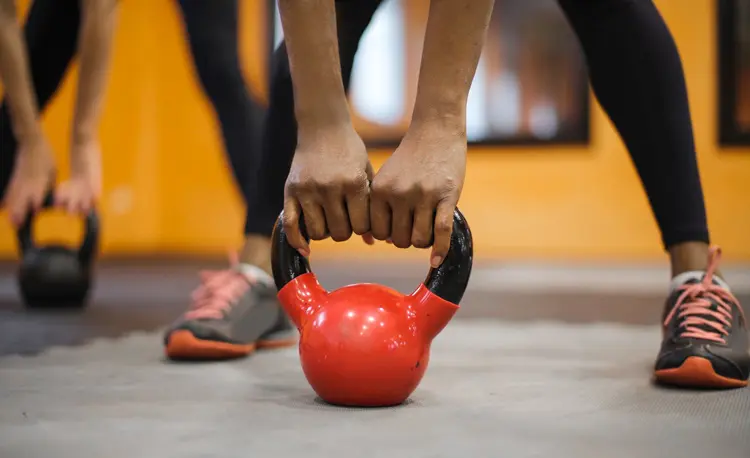
Swings are also an excellent total-body conditioning exercise. Crab walks DO challenge your triceps more than swings, but that deficiency can be quickly remedied with a few sets of push-ups.
How to do it:
- Hold your kettlebell in front of your hips and stand with your feet shoulder-width apart. Brace your abs and pull your shoulders down and back.
- Bending your knees slightly, hinge from your hips, and lower the weight down to between your knees. Do not round your lower back.
- Drive your hips forward and use this momentum to swing the kettlebell up to shoulder height. Keep your arms straight.
- Swing the weight back down and repeat.
Check out our kettlebell related content.
7. Glute march
Crab walks are a challenging glute exercise but may be too hard for some people, especially if you are a little on the heavy side or your arms aren’t strong enough. Glute marches let you train your lower body while taking your arms out of the movement.
How to do it:
- Sit on the floor with your back against a stable exercise bench. Lift your hips, so your body is parallel to the floor with your shins vertical. Brace your abs and tense your glutes.
- Lifting and lowering your legs alternately, march on the spot without dropping your hips.
- Make this exercise harder by resting and holding a weight on your hips.
Wrapping Up
When it comes to bodyweight exercises, many people focus on things like push-ups, squats, and lunges. And while there is nothing wrong with these movements, there are plenty of other things you can do as well or instead.
Crab walks are not a typical or traditional exercise, but they are still effective and beneficial. They’re also a lot harder than they look.
Try adding crab walks to your HIIT workouts, or just do them as part of your warm-up before moving on to heavy barbell deadlifts and squats. Either way, crab walks deserve to be part of your training.
Interested in measuring your progress? Check out our strength standards for Push Ups, Deadlift, Leg Extension, and more.

